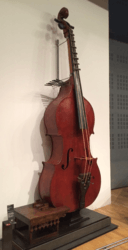Octobass
|
Photo of an Octobass at Musée de la Musique, Paris. | |
| Classification | |
|---|---|
| Related instruments | |
The octobass is an extremely large bowed string instrument that was first built around 1850 in Paris by the French luthier Jean-Baptiste Vuillaume (1798–1875). It has three strings and is essentially a larger version of the double bass (the specimen in the collection of the Musée de la Musique in Paris measures 3.48 meters in length, whereas a full size double bass is generally approximately 2 meters in length). Because of the extreme fingerboard length and string thickness, the musician plays it using a system of levers and pedals. It has never been produced on a large scale or used much by composers (though Hector Berlioz wrote favorably about the instrument and proposed its widespread adoption). In addition to the Paris instrument, octobasses exist in the collections of the Musical Instrument Museum in Phoenix, Arizona and the Kunsthistorisches Museum in Vienna.[1]
In October 2016, the Montreal Symphony Orchestra was donated an octobass by the Quebec company Canimex and is now the only orchestra in the world to own one.[2][3] This instrument was made by the luthier Jean-Jacques Pagès of Mirecourt, France in 2010.[4]
Range and tuning
According to Berlioz, the three open strings were tuned C1, G1, and C2. This tuning gave it a low range one octave below the cello and equal to the modern double bass with low C extension. However, at the time when the octobass was invented, the double bass lacked this extension and could descend only to E1 or G1. The mechanism enabled each string to chromatically cover the range of a perfect fifth and gave the instrument a high range to G2.[5] The instrument at the Musée de la Musique in Paris, which uses period-accurate gut strings, is tuned thus (though on at least some recordings the overall tuning is a half-step flat).[6]
.png)
The instrument at the Musical Instrument Museum in Phoenix, which uses modern wound metal strings, is tuned C0, G0, D1. This tuning gives it a low range two octaves below the cello and one octave below the modern double bass with low C extension. Berlioz specifically noted this tuning in his orchestration treatise, but considered it erroneous. As on the Paris instrument, the mechanism allows each string to cover a perfect fifth, giving it a high range to A1. The lowest notes in this tuning exceed the commonly-stated human hearing range of 20 Hz, but are nevertheless audible due to overtones.[7] (An organ's 32′ stop also exceeds the supposed 20 Hz limit.)
.png)
The Montreal Symphony Orchestra octobass uses gut strings, is tuned A0, E1, B1 and has a high range to F♯2.[8]
.png)
See also
Triple contrabass viol - A similar, but more recent, instrument that has appeared on a recording by the American composer Roscoe Mitchell.
References
- ↑ McDonald, Huge; Berlioz, Hugh (2002). Berlioz's Orchestration Treatise : a Translation and Commentary. Cambridge, NY: Cambridge University Press. p. 318. ISBN 9780511481949.
- ↑
- ↑ Un géant entre à l'OSM. Le Téléjournal, Radio Canada. Retrieved 18 October 2016.
- ↑ Canimex acquiert une octobasse pour l'OSM (in French)
- ↑ Berlioz, Hector (1848). Treatise on Instrumentation. Mineola, NY: Dover Publications. p. 405. ISBN 0486269035.
- ↑ Octobasse @ Cité de la musique, Paris. Retrieved 20 October 2016.
- ↑ Up Close With A Curator: Octobasse. Retrieved 20 October 2016.
- ↑ OSM Octobass. Retrieved 20 October 2016.

